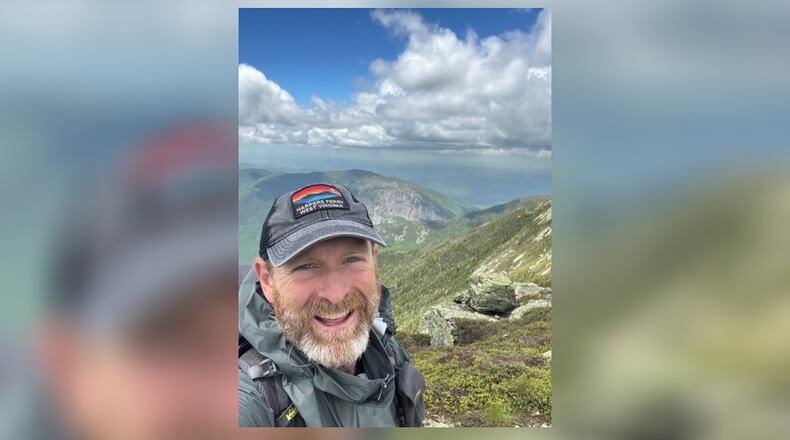Schellenbach, a 1991 Badin High School grad, was “seriously into long-distance hiking” when he suffered a fractured vertebrae in a February 2021 car accident.
“I thought — this could be the end of it for me,” he said of his hiking efforts. “I wanted to do the Appalachian Trail, but what if I can’t? It was tearing at me. It was on my mind every day. Finally I just said, ‘I’ve got to go for it.’’'
Schellenbach — a resident of Kannapolis, N.C., with his wife, Ann, and three children — got terrific help from his partners as he put his real estate business on pause, and said his wife was “extremely supportive” in his quest.
He got himself prepared and shoved off from the southern terminus at Springer Mountain, Ga., on March 1, chronicling his travels on social media throughout.
“I was considered a ‘NOBO’ (north-bound) because I was heading north,” he said. “Sometimes you’re hiking solo, but you run into people and you hike with them for awhile. And you typically see people at the shelters.”
The Appalachian Trail is the most well-known of three “Triple Crown” trails in North America. There are shelters about every 15 miles. On fast days, Schellenbach noted, he’d put as many as 30 miles behind him. On slower days, it would be 15 miles.
“I had been out for awhile, maybe a quarter of the way through, and I got shin splints real bad,” he recalled. “I was able to work my way through those. You get to a shelter, you sign the log book and make an entry, and then you keep going.”
Keep going, for example, through deep snow in the Smoky Mountains in March, and through shin-deep water in Pennsylvania in the spring.
“There are so many good people on the trail who want to help you,” he said. “It really brings back your faith in humanity. It gives you a really good feeling about the community of people. I never had a bad experience.”
Schellenbach had been in the National Guard for nine years as a combat engineer, so he knew what he needed for the trek. His backpack weighed some 30 pounds. He’d drink more than two gallons of water a day to stay hydrated. He’d get four days of food at a time and then find his way into nearby towns to resupply.
“During the hike, I’d eat trail mix, protein bars, chicken packets and Ramen noodles,” he said. “When I’d get into a town every four or five days, I would eat unimaginable amounts of food.”
Of course, Schellenbach did have several of what he called “eye-opening” experiences.
One day, he took a step, and was about to take another step, when he noticed a rattlesnake quickly coiling next to the path, prepared to strike. “I was able to step away from it in a hurry,” he said. “I didn’t have time to be scared.”
“You hear rustling all the time in the brush,” he added. “If you looked in the brush every time you heard rustling, you’d be doing that all day. You’d never get anywhere.”
Fortunately, one day on Mount Greylock in Massachusetts, he did look up at the rustling — and saw two bears rushing toward him, about 30 yards away.
“It happened so quickly, I just froze,” he said. “But fortunately they dropped to the ground and started fighting with each other. That gave me time to start banging my poles together and yell at them. My heart was beating really fast. They jumped up and ran off.”
Moving through that high water in Pennsylvania one day, needing nine more miles to get to a shelter, the trail led across a beaver dam — which Schellenbach slipped off of into water over his head.
“I was able to climb back on top of the dam — but I knew I had to get moving because the temperatures were in the low 40s and I had to get a change of clothes and into a sleeping bag before hypothermia set in,” he recalled. “I finally made it to the shelter as nightfall came. That was one of those days that I’ll never forget for the rest of my life.”
On top of Mount Washington in New Hampshire, still snow-covered in June, Schellenbach marveled that he could see for miles.
“That was very cool,” he said. “The highest wind speeds in the world have been recorded up there. It has almost a Mars-like landscape, it’s so windy. But it’s a beautiful place – you can see forever. I’m going back there someday.”
In fact, that’s an ongoing theme of Appalachian Trail conversation with Schellenbach, who played for Badin’s 1990 state championship football team — going back.
His trek from Georgia to Mount Katahdin, Maine, took 121 days from March 1 to June 29.
“I really enjoyed it,” Schellenbach said. “You miss hot showers, and cold drinks. You’ll never take a hot shower for granted again.
“I think everyone should get out and go on a long hike,” he added. “I feel very accomplished. I’m so glad that I did it.”
About the Author
